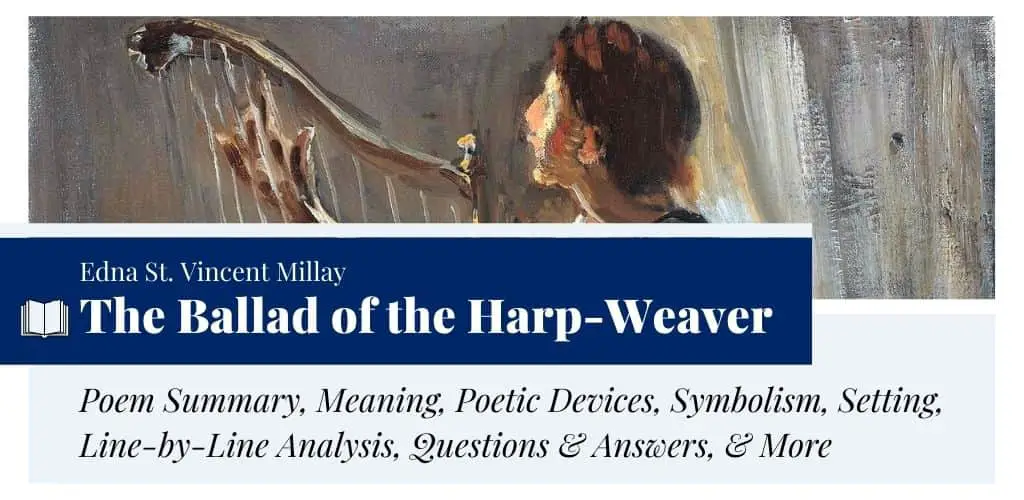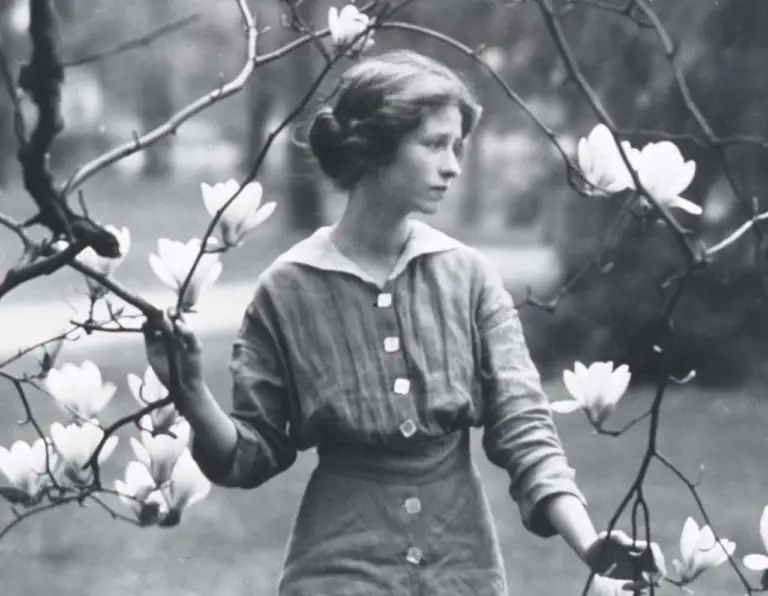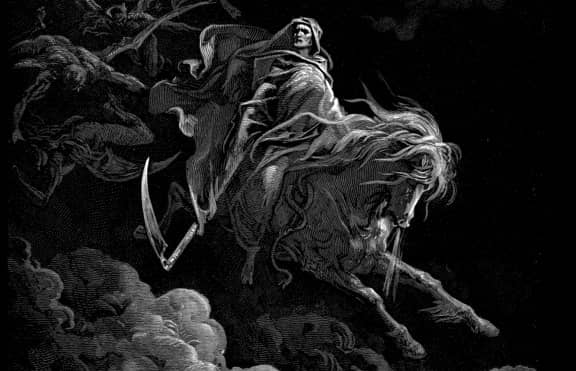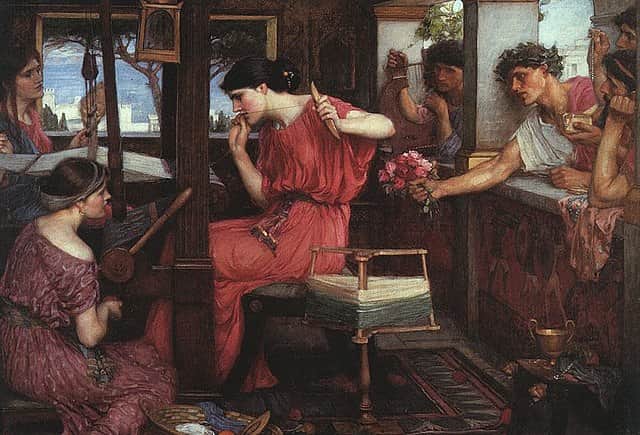The Ballad of the Harp-Weaver by Edna St. Vincent Millay
“The Ballad of the Harp-Weaver” is written by one of the best-loved feminist poets of the 20th-century, Edna St. Vincent Millay. It’s considered one of Millay’s important poems. She won the Pulitzer Prize for Poetry in 1923 for the collection The Harp-Weaver, and Other Poems. This poem features a tragic story of a poor, helpless mother and son, the mother’s struggle to provide for the fatherless son, and her urge to do something within her abilities. She herself is unfed and not fully prepared to fight winter, yet she concentrates on the condition of her only son. In the end, she dies quite heroically, with her cold hands on the harp strings and a room full of clothes for her son, which is what makes the ending both tragic and emotional. The poem was first published in the June 1922 issue of Vanity Fair magazine.
- Read the full text of “The Ballad of the Harp-Weaver” below:
The Ballad of the Harp-Weaver (1922) by Edna St. Vincent Millay “Son,” said my mother, When I was knee-high, “You’ve need of clothes to cover you, And not a rag have I. “There’s nothing in the house To make a boy breeches, Nor shears to cut a cloth with Nor thread to take stitches. “There’s nothing in the house But a loaf-end of rye, And a harp with a woman’s head Nobody will buy,” And she began to cry. That was in the early fall. When came the late fall, “Son,” she said, “the sight of you Makes your mother’s blood crawl,— “Little skinny shoulder-blades Sticking through your clothes! And where you’ll get a jacket from God above knows. “It’s lucky for me, lad, Your daddy’s in the ground, And can’t see the way I let His son go around!” And she made a queer sound. That was in the late fall. When the winter came, I’d not a pair of breeches Nor a shirt to my name. I couldn’t go to school, Or out of doors to play. And all the other little boys Passed our way. “Son,” said my mother, “Come, climb into my lap, And I’ll chafe your little bones While you take a nap.” And, oh, but we were silly For half an hour or more, Me with my long legs Dragging on the floor, A-rock-rock-rocking To a mother-goose rhyme! Oh, but we were happy For half an hour’s time! But there was I, a great boy, And what would folks say To hear my mother singing me To sleep all day, In such a daft way? Men say the winter Was bad that year; Fuel was scarce, And food was dear. A wind with a wolf’s head Howled about our door, And we burned up the chairs And sat upon the floor. All that was left us Was a chair we couldn’t break, And the harp with a woman’s head Nobody would take, For song or pity’s sake. The night before Christmas I cried with the cold, I cried myself to sleep Like a two-year-old. And in the deep night I felt my mother rise, And stare down upon me With love in her eyes. I saw my mother sitting On the one good chair, A light falling on her From I couldn’t tell where, Looking nineteen, And not a day older, And the harp with a woman’s head Leaned against her shoulder. Her thin fingers, moving In the thin, tall strings, Were weav-weav-weaving Wonderful things. Many bright threads, From where I couldn’t see, Were running through the harp-strings Rapidly, And gold threads whistling Through my mother’s hand. I saw the web grow, And the pattern expand. She wove a child’s jacket, And when it was done She laid it on the floor And wove another one. She wove a red cloak So regal to see, “She’s made it for a king’s son,” I said, “and not for me.” But I knew it was for me. She wove a pair of breeches Quicker than that! She wove a pair of boots And a little cocked hat. She wove a pair of mittens, She wove a little blouse, She wove all night In the still, cold house. She sang as she worked, And the harp-strings spoke; Her voice never faltered, And the thread never broke. And when I awoke,— There sat my mother With the harp against her shoulder Looking nineteen And not a day older, A smile about her lips, And a light about her head, And her hands in the harp-strings Frozen dead. And piled up beside her And toppling to the skies, Were the clothes of a king’s son, Just my size. - from The Harp-Weaver, and Other Poems (1923)

Summary
In “The Ballad of the Harp-Weaver,” a poor boy tells the story of his mother’s sacrifice. The story has three timeframes. First, the speaker talks about the situation during the early fall or autumn. Then, he continues to share what happened during the late fall and in the winter. In the early winter, the mother had nothing to prepare her son for the winter, nor did she have enough food to sustain themselves. During the late winter, the son’s poor state made her blood crawl in agony. She thought what his father would think if he was alive.
Their situation became more desperate when the winter came. The boy neither had proper clothing to go to school nor even to go out and play. Thus, his mother made him sit in her lap and lulled him to sleep all day long. That year the winter was so bad that his mother became more anxious.
The night before Christmas, she took out the harp with a woman’s head, their only valuable property (none would buy), and sat on their only chair left. Then she played on the harp, and magically beautiful clothes were woven out of the melody. She weaved throughout the night. When the speaker awoke, he found his mother frozen to death, but there was an abundance of clothes “just his size.”
Meaning
The title of the poem “The Ballad of the Harp-Weaver” signifies the dual role of the mother, the central figure of the story. Millay shows how her motherhood fuses her passion with livelihood in order to protect her only child. The term “Harp-Weaver” hints at how the mother weaved regal clothes for her son by playing on the harp. Ironically, the music she loves cannot soothe her child, but the clothes (an outcome of weaving) can. This situation draws readers’ attention to the fact that a woman has to sacrifice her hobbies for her family. In this case, the woman dies suffering from winter, but she keeps the motherhood alive by leaving behind a house full of clothes for her son.
Form, Rhyme Scheme, & Meter
Structure & Form
Millay’s “The Ballad of the Harp-Weaver” is written in ballad form. Structurally, the text does not consist of only quatrains (four-line stanzas). At the end of each movement, there is a five-line stanza. Millay writes this poem from the first-person point of view, told from the perspective of the son. The poet also features the mother’s dialogues within in order to showcase the mindset of each character. There is a set rhyme scheme and meter in the text that are discussed below.
Rhyme Scheme
The poem has the ballad rhyme scheme that is ABCB. It means the second and fourth lines end with the same rhyme. For instance, in the first quatrain, “high” rhymes with “I”. In the case of five-line stanzas, the rhyme scheme is ABCBB. The end rhyme of the second line is used at the end of the last two lines. For instance, in the third stanza, “rye” rhymes with “buy” and “cry”.
Meter
The poem is written in the iambic trimeter with a number of variations. Let’s have a look at the scansion of the first two stanzas:
“Son,” said/ my moth(e)r,
When I/ was knee-high,
“You’ve need/ of clothes/ to co/-ver you,
And not/ a rag/ have I.
“There’s no/-thing in/ the house
To make/ a boy/ bree-ches,
Nor shears/ to cut/ a cloth/ with
Nor thread/ to take/ sti-tches.
“There’s no/-thing in/ the house
But/ a loaf-end/ of rye,
And a harp/ with a wo/-man’s head
No/-bo-dy/ will buy,”
And she/ be-gan/ to cry.
The first two lines are in iambic dimeter. Thereafter, all the lines are in iambic trimeter. Now, let’s see how the last three stanzas sound:
There sat/ my moth(e)r
With the harp/ a-gainst/ her should(e)r
Look-ing/ nine-teen
And not/ a day/ ol-der,
A smile/ a-bout/ her lips,
And a light/ a-bout/ her head,
And/ her hands/ in the harp-strings
Fro/-zen dead.
And piled/ up be/-side her
And top/-pling to/ the skies,
Were the clothes/ of a/ king’s son,
Just/ my size.
The same scheme is followed in these lines, with the significant meter being iambic trimeter and a few iambic dimeter variations.
Poetic Devices & Figurative Language
Millay uses the following poetic devices in “The Ballad of the Harp-Weaver”:
Repetition
The line “There’s nothing in the house” is repeated twice at the beginning of the second and third stanzas. This repetition conveys the dire condition of the speaker and her son. There is also a repetition of the term “fall” (autumn) that describes the similarity between mellowing nature and their condition. Moreover, the repetition of the “harp with a woman’s head” makes it an important symbol.
Alliteration
The poem begins with the alliteration of the “s,” and “m” sounds in “Son” and “said”; “my mother”. It also occurs in the following phrases:
- “clothes to cover”
- “boy breeches”
- “cut a cloth”
- “Son, she said”
- “Makes your mother’s”
- “skinny shoulder-blades”
- “Come, climb,” etc.
Anaphora
It occurs in the last two lines of the second stanza:
Nor shears to cut a cloth with
Nor thread to take stitches.
Anaphora is used in these lines for the sake of emphasis. It also occurs in:
- “To hear my mother singing me/ To sleep all day”
- “And we burned up the chairs/ And sat upon the floor”
- “I cried with the cold,/ I cried myself to sleep”
- “And not a day older,/ And the hard with a woman’s head,” etc.
Enjambment
This device is also used in a number of instances. For example, the following lines are enjambed:
“Son,” “she said, “the sight of you
Makes your mother’s blood crawl—”
This device makes readers go through the lines altogether to grasp the speaker’s idea.
Personification
In the line, “Makes your mother’s blood crawl,” an inanimate idea of “blood” is personified. The “wind” is personified in the following lines:
A wind with a wolf’s head
Howled about our door,
Millay personifies the “gold threads” and invests them with the idea of whistling. The “harp-strings” are also given the human feature of speaking.
Rhetorical Exclamation
Rhetorical exclamations are used to convey some deeper emotions such as grief, shock, excitement, etc. For instance, it occurs in:
- “Sticking through your clothes!”
- “His son go around!”
- “To a mother-goose rhyme!”
- “For half an hour’s time”
- “Quicker than that!”
Stanza-by-Stanza Analysis & Explanation
Stanza One
“Son,” said my mother,
When I was knee-high,
“You’ve need of clothes to cover you,
And not a rag have I.
Millay’s “The Ballad of the Harp-Weaver” begins with a preliminary sketch of the main characters: a mother and son. The mother cared for her poor son, who was only knee-high. Millay writes this poem from the perspective of the son. He narrates the story in the past tense. At that time, they were so poor that her mother did not have a “rag” to cover him. In the last line, Millay uses inversion by changing the order of words for poetic effect.
Stanza Two
“There’s nothing in the house
To make a boy breeches,
Nor shears to cut a cloth with
Nor thread to take stitches.
In the second stanza, readers can sense the sadness and desperation in the mother’s voice. There was nothing in the house to make the boy breeches. She did not have shears (a cutting tool similar to scissors) to cut cloth, nor did she have a thread to weave. The use of anaphora in the last two lines connects them internally and makes the speaker’s statement compelling.
Stanza Three
“There’s nothing in the house
But a loaf-end of rye,
And a harp with a woman’s head
Nobody will buy,”
And she began to cry.
There was no food in their house except bits of a rye loaf. Their only prized possession was a harp with a woman’s head. They lived during a time when people were no longer attached to good music or musical instruments. Therefore, they could not sell it for clothes or food. It made the mother so sad that she started to cry out of agony and helplessness. A desperate urge to do something to protect her child was there in her dropping voice.
Stanza Four
That was in the early fall.
When came the late fall,
“Son,” she said, “the sight of you
Makes your mother’s blood crawl,—
In the fourth stanza, the narrator discloses that it was during the early fall or autumn when her mother thought so. When the fall was about to end, and winter approached, she became more anxious. Naturally, due to lack of food, the son’s body weakened. Just the sight of him made her blood crawl in apprehension and pain. Somehow she became angry with herself that she could not do anything for her only child.
Stanza Five
“Little skinny shoulder-blades
Sticking through your clothes!
And where you’ll get a jacket from
God above knows.
The son’s skinny shoulder blades could be discerned from his ragged clothes that were sticking through his clothes. His mother thought, how he would get a jacket to protect himself from approaching winter. She was pretty dejected at God. Only God knew how they could live past the winter. Such was their state in the late fall.
Stanza Six
“It’s lucky for me, lad,
Your daddy’s in the ground,
And can’t see the way I let
His son go around!”
And she made a queer sound.
The mother thought herself lucky as his father died. Otherwise, his father would get infuriated at his son’s poor condition. He would have held her responsible for not caring for their only son. There is a bitter tinge of irony here as the mother was a bit relieved as her husband was not alive. Like any patriarch, he would increase the pain that was already there in her heart with cruel blames. Thus, she made a “queer” sound that the boy, due to his innocence, could not understand.
Stanza Seven
That was in the late fall.
When the winter came,
I’d not a pair of breeches
Nor a shirt to my name.
Then finally came the winter. As the mother spent the entire fall season lamenting, she had not managed to get clothes for her son. The narrator says he neither had a pair of breeches (short trousers fastened just below the knee) nor a shirt. From his mother’s inability, readers get to know the socio-economic condition of the 1920s when “The Ballad of the Harp-Weaver” was written.
It was hard for a classical harp player to get a job. Housewives and women, in general, lacked the essential skills (or education) to provide for themselves and their children. Naturally, they had to live on the earnings of a male (their husband or father). In the case of the woman in the poem, she only had her husband to look after them. When he passed away, she was literally lost and could not find a way to make a living.
Stanza Eight
I couldn’t go to school,
Or out of doors to play.
And all the other little boys
Passed our way.
As the boy in “The Ballad of the Harp-Weaver” did not have a proper uniform, he could not go to school. He neither had warm clothes to go out and play with other kids. When the other boys passed by their house, it made him sad. He also wanted to play with them. In this way, Millay contrasts the boy’s life with the others’.
Stanza Nine
“Son,” said my mother,
“Come, climb into my lap,
And I’ll chafe your little bones
While you take a nap.”
His mother understood that her boy was in pain. So, she cajoled him into climbing up into her lap. Then she warmed him by holding her tightly and telling him to take a nap. There was nothing she could do except comfort her son. She thought, in this way, he could understand how much she loved him. The situation was not in her favor.
Stanza Ten
And, oh, but we were silly
For half an hour or more,
Me with my long legs
Dragging on the floor,
The narrator’s mother made him forget about everything. For half an hour, they played some silly mother-child games. The boy was grown up. His whole body could not fit into his mother’s lap. Thus, his long legs dragged on the floor when his mother played with him. It somehow reminded the boy of his early childhood days when he was little.
Stanza Eleven
A-rock-rock-rocking
To a mother-goose rhyme!
Oh, but we were happy
For half an hour’s time!
Then his mother sang a mother-goose rhyme and rocked him to its rhythm. The compound “A-rock-rock-rocking” reflects his sense of happiness. Alongside that, the consecutive usage of rhetorical exclamations also hints at the speaker’s momentary enjoyment. That “half an hour’s time” made them forget about all their worries.
Stanza Twelve
But there was I, a great boy,
And what would folks say
To hear my mother singing me
To sleep all day,
In such a daft way?
However, the narrator was quickly reminded of his condition as the happy moments slipped away. He was a grown-up boy. There was a sense of manhood growing within. So, he thought about what others would say if they came to know that he slept on his mother’s lap all day long. It seemed to him a “daft” or foolish way of passing the whole day as a grown-up.
Stanza Thirteen
Men say the winter
Was bad that year;
Fuel was scarce,
And food was dear.
In the thirteenth stanza of “The Ballad of the Harp-Weaver,” the narrator describes the winter of that year. The winter was harsh and colder than in previous years. There was a scarcity of fuel and food. Those who had both could not share with others due to the bad weather. Therefore, the mother could not ask her neighbors for fuel or food.
Stanza Fourteen
A wind with a wolf’s head
Howled about our door,
And we burned up the chairs
And sat on the floor.
In the first two lines, Millay’s speaker personifies the wind. He metaphorically compares the wind to a “wolf” howling about their door. The harsh chilly wind appeared as a wild beast that seemed to devour the mother and son. They burned up their chairs and sat on the floor to keep them warm.
Stanza Fifteen
All that was left us
Was a chair we couldn’t break,
And the harp with a woman’s head
Nobody would take,
For song or pity’s sake.
There was only a chair left that they could not break for fuel. Nor could they use the harp with a woman’s head. In the last two lines, the speaker ironically says that none would take the harp for art’s sake or out of pity for the instrument. Though they would sympathize with the instrument, they could not help the family. Such was the mindset of people. They were too selfish to help someone out of their misery.
Stanza Sixteen
The night before Christmas
I cried with the cold,
I cried myself to sleep
Like a two-year-old.
Finally, the night before Christmas came. This is the final shift in the poem. After that, the story reaches its climax. That night, the speaker cried out in the cold and kept crying until he slept. It seemed as if he was a two-year-old infant. Millay uses a simile in the last two lines by comparing the boy to an infant.
Stanza Seventeen
And in the deep night
I felt my mother rise,
And stare down upon me
With love in her eyes.
In the middle of the night, the boy felt his mother rise from his side. She stared down upon him with love in her eyes. She could not sleep because of her child’s pain. Thus, she got up from the bed and tried to do something to ease his pain.
Stanza Eighteen
I saw my mother sitting
On the one good chair,
A light falling on her
From I couldn’t tell where,
After that, she sat on the only chair left in their home. The boy saw the light falling on her. He could not tell where it was coming from. Probably, it was some divine grace that filled the mother’s spirit with some magical abilities.
Stanza Nineteen
Looking nineteen,
And not a day older,
And the harp with a woman’s head
Leaned against her shoulder.
Graced with the light, she looked mere nineteen. The boy felt his mother became a teen again, just like she looked when he was born. Then she took the harp and leaned it against her shoulder. She tried to ease her sadness by playing the harp. It might help her son to sleep.
Stanza Twenty
Her thin fingers, moving
In the thin, tall strings,
Were weav-weav-weaving
Wonderful things.
In these lines, the narrator describes how her mother’s fingers moved along the strings of the harp by using tactile imagery. It appeared as if her mother weaved wonderful things alongside creating music on the harp. From this reference, it becomes clear the mother got some magical abilities when the mysterious bright light fell upon her.
Stanza Twenty-One
Many bright threads,
From where I couldn’t see,
Were running through the harp-strings
Rapidly,
There were several glowing threads that came out of the harp strings. The narrator was unable to see where it came from as everything was happening so fast. Thus the harp turned into a magical weaving instrument with his mother’s touch. It is important to note the sound shift in the fourth line that only contains a trisyllabic word “Ra-pid-ly”. The shortening of the line portrays the pace with which the threads came running out of the harp.
Stanza Twenty-Two
And gold threads whistling
Through my mother’s hand.
I saw the web grow,
And the pattern expand.
It seemed the gold threads were whistling while his mother weaved on the harp. The speed of the threads made this whistling sound. It is an example of auditory imagery that conveys the sound behind a scene. Gradually, the web grew more extensive, and the pattern expanded into something meaningful and concrete. The quickness of threads made the speaker quite dazzled, as evident in his tone.
Stanza Twenty-Three
She wove a child’s jacket,
And when it was done
She laid it on the floor
And wove another one.
In this way, the mother became a “harp-weaver” who could weave clothes while playing her harp. One by one, she wove a jacket for her son. When it was completed, she laid it down on the flood and started working on another. She was so lost in the process that she could not notice her son was awake. Moreover, it seems she was happy with what she was doing. All her anxieties faded that night.
Stanza Twenty-Four
She wove a red cloak
So regal to see,
“She’s made it for a king’s son,”
I said, “and not for me.”
But I knew it was for me.
Then she wove a red cloak for her son. Kings wore such red cloaks that she made it for her only son. The narrator at first thought the cloak was not for him. She probably wove it for a king’s son. Inwardly, he knew it was for him. For his mother, he was no less than a king’s son.
Stanza Twenty-Five
She wove a pair of breeches
Quicker than that!
She wove a pair of boots
And a little cocked hat.
Moreover, she wove a pair of breeches. She made it much faster than the red cloak. The pace reflected her involvement and attachment with the work. Then she wove a pair of boots and a little cocked hat for her son. All that year, her son lived without clothes. Thus, she became so determined that she wove every dress that a child from a well-off family wore.
Stanza Twenty-Six
She wove a pair of mittens,
She wove a little blouse,
She wove all night
In the still, cold house.
In this stanza, the narrator lists other items that his mother wove for him. She made a pair of mittens (gloves) and a little blouse. In that still, cold house, she kept weaving all night. The use of anaphora – the repetition of the phrase “she wove” at the beginning of successive clauses – depicts continuity. The mother did not stop for a moment while weaving clothes for her son.
Stanza Twenty-Seven
She sang as she worked,
And the harp-strings spoke;
Her voice never faltered,
And the thread never broke.
And when I awoke,—
The fact that she was enjoying what she was doing is reflected in the first line of this stanza: “She sang as she worked.” It seemed as if she became integrated to the harp and not she, but the harp-strings sang the verses. Her voice never faltered throughout the night. Likewise, the thread never broke. In the last line, the narrator quickly shifts to the scene of the morning the following day.
Stanza Twenty-Eight
There sat my mother
With the harp against her shoulder
Looking nineteen
And not a day older,
In this stanza of “The Ballad of the Harp-Weaver,” the audience discovers the tragic incident. When the boy woke up the following day, he found his mother sitting with the harp against her shoulder. She neither looked tired nor older. The speaker describes that she looked just the same as last night: “Looking nineteen/ And not a day older.”
Stanza Twenty-Nine
A smile about her lips,
And a light about her head,
And her hands in the harp-strings
Frozen dead.
The “smile” at the end of her silent lips tells the audience much more than words can convey. This simple scene makes us think about how satisfied the mother was while she played the harp. She was more satisfied by the fact that her child would no longer have to suffer in the cold. The light was shining similarly about her head. But, there was only one change that made a big difference. The mother froze to death with her hands in the harp strings, just like any passionate artist would like to die. Her “smile” the peace and contentment with which she died.
Stanza Thirty
And piled up beside her
And toppling to the skies,
Were the clothes of a king’s son,
Just my size.
In the last quatrain of “The Ballad of the Harp-Weaver,” the speaker depicts the clothes piled beside her chair. Millay uses hyperbole in the phrase, “toppling to the skies.” The clothes seemed piled up to the sky as he was merely “knee-high”. The phrase also reflects a child’s astonishment at such a scene. All the clothes were like that of a king’s son and were his size. The reference to the “size” of clothes also hints at the fact that the mother was as skillful at weaving as she was in playing a harp and singing. She was indeed an admirable character throughout the whole poem.
Symbolism
The most important symbol of the poem is the “harp with a woman’s head”. Millay’s addition of a “woman’s head” symbol at the top of the harp makes it an apt representation of the woman: a caring mother and an adept musician. This harp becomes the main point of attraction in the climax, where it becomes an instrument of sustenance. The mother had nothing to weave with, but having the harp made it possible for her to weave clothes for her son. Besides, the “light” shining about the mother’s head is a symbol of divine grace. Through the reference of the light, Millay tries to convey that God is always there for those who seek him.
Setting, Plot, & Characters
Setting
“The Ballad of the Harp-Weaver” is set in early 20th-century America. There is a unity of place as the whole poem is set in the room. The poem begins in early fall and ends on Christmas (late winter). It is set in a poor household where there is no food or clothes. There are a few chairs that are used up later in the poem and a harp with a woman’s head.
Plot
The poem revolves around a mother lamenting the poor condition of her son. She badly wanted to dress her son in proper clothing as winter was nearing. There is a magical twist in the plot near the ending where the mother wove clothes for her son with her harp.
Characters
There are two main characters present in the poem: the mother and the son. Both characters are poor, and Millay specifically draws readers’ attention to the boy’s condition. He had no clothes, and he was weak due to a lack of food.
Historical Context
One of Millay’s finest poems, “The Ballad of the Harp-Weaver,” first appeared in the June 1922 issue of the Vanity Fair magazine with a drawing by Hogarth Jr. It was published in the couplet form with a number of tercets in between. When Frank Shay published the poem as a book in 1922, he ordered the lines in quatrains and five-line stanzas. Millay won the Pulitzer Prize for Poetry for The Harp-Weaver, and Other Poems in 1923, becoming the third woman to win the prize after Sara Teasdale and Margaret Widdemer. In this poem, the character of the woman seemed to be influenced by Millay’s mother, Cora Lounella Buzelle, who also cared for her daughters. The boy could be a representation of Millay herself as she preferred to call herself “Vincent” (typically a male name). Through this piece, Millay explores the mother-child relationship with particular emphasis on poverty.
Questions & Answers
“The Ballad of the Harp-Weaver,” one of the best-loved poems of Edna St. Vincent Millay, explores the theme of the mother-son relationship with particular emphasis on poverty and motherhood. This poem is about a mother who has nothing to weave her son’s winter clothes. She becomes pretty emotional to see her son weakening due to the lack of food. When winter comes, she grows more anxious. However, a magical incident happens the night before Christmas when she weaves various clothes while playing the harp with a woman’s head, their only possession. Lastly, she dies with a smile on the verge of her lips, signifying a sense of satisfaction. In this way, Millay also utilizes the theme of the mother’s selfless love for her son.
“The Ballad of the Harp-Weaver,” considered one of Millay’s finest poems, was written in 1922. It was first published in Vanity Fair magazine in June 1922. Initially, the term “Harp-Weaver” was not hyphenated, and the lines were grouped into couplets and tercets. Later, Frank Shay published the poem in 1922 in the book format and organized the lines in the current quatrain-quintain form.
The mother wove a jacket, a red cloak, a pair of breeches, a pair of boots, a little cocked hat, a pair of mittens, a blouse, and several other clothes for her son.
“The Ballad of the Harp-Weaver” revolves around the plot of a mother lamenting her son’s poor state and brooding over her inability to do something for him.
“The Ballad of the Harp-Weaver” is set in a 20th-century poor American household. The poem begins in the early fall, and the climax occurs on the night before Christmas.
Similar Poems about Mother-Child Relationship & Poverty
- “Fear” by Gabriela Mistral — This poem is about a mother’s apprehensions regarding her daughter’s future.
- “Sita” by Toru Dutt — This poem features a mother’s love for her children.
- “The Centaur” by May Swenson — In this poem, Swenson depicts a girl playing all day long and her mother’s reaction when she comes home.
- “Who Burns for the Perfection of Paper” by Martín Espada — This poem features the suffering of the poor for the perfection of society.
External Resources
- Check out the Illustrated Children’s Book on Millay’s Ballad — This picture book on Millay’s “The Ballad of the Harp-Weaver” with vivid illustrations by Beth Peck is highly recommended for children.
- Check out The Harp-Weaver, and Other Poems (1923) — Millay became the first woman to recieve the Pulitzer Prize for Poetry for this collection, which she dedicated to her mother.
- Millay Reading the Poem — Listen to Millay’s powerful voice as she reads “The Ballad of the Harp-Weaver”.
- About Edna St. Vincent Millay — Read about the poet’s life.
- Poet Profile of Edna St. Vincent Millay — Learn more about Millay and her works.






